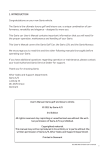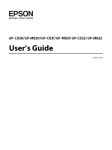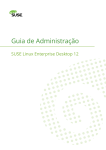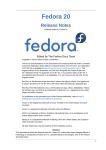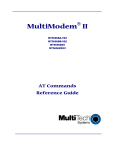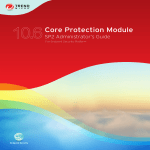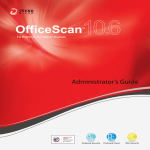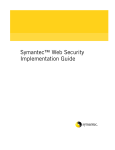Download Exploitation documentation - FusionForge de l`ADULLACT
Transcript
Security of Information and Communication Systems
USER MANUAL
This document describes how to administer ALCASAR with the ALCASAR Control Center (ACC) or by using
Linux command lines.
Project : ALCASAR
Author : Rexy and 3abtux with support of « ALCASAR Team ». Thanks
to the main translator (Clément).
Object : User manual
Version : 2.9
Keywords : captive portal, access control, accountability, traceability, authentication
Date : 2015 March
User manual
ALCASAR – 2.9
1/37
Table of contents
1.Introduction.........................................................................................................................................................3
2.Network settings..................................................................................................................................................4
2.1.ALCASAR settings...................................................................................................................................................5
2.2.Client devices settings...............................................................................................................................................5
3.Managing users and their devices........................................................................................................................7
3.1.Network activity.......................................................................................................................................................7
3.2.Creating groups.........................................................................................................................................................8
3.3.Editing and removing a group...................................................................................................................................9
3.4.Creating users...........................................................................................................................................................9
3.5.Searching and editing users.....................................................................................................................................10
3.6.Importing users.......................................................................................................................................................11
3.7.Emptying the user database.....................................................................................................................................11
3.8.Authentication exceptions.......................................................................................................................................11
3.9.Auto-registration via SMS......................................................................................................................................12
4.Filtering.............................................................................................................................................................15
4.1.Blacklist and whitelist.............................................................................................................................................15
4.2.Protocol filtering.....................................................................................................................................................16
5.Access to Statistics............................................................................................................................................17
5.1.Number of connections per user per day.................................................................................................................17
5.2.Connection status of users.......................................................................................................................................17
5.3.Daily use................................................................................................................................................................. 18
5.4.Global and detailed traffic.......................................................................................................................................18
5.5.Security Report.......................................................................................................................................................20
6.Backup...............................................................................................................................................................20
6.1.Connection logs......................................................................................................................................................20
6.2.The users database..................................................................................................................................................21
7.Advanced features.............................................................................................................................................21
7.1.Administration accounts management....................................................................................................................21
7.2.Secure administration across the Internet................................................................................................................21
7.3.How to display your logo ?.....................................................................................................................................24
7.4.Server certificate.....................................................................................................................................................24
7.5.Use of an external directory server (LDAP or AD).................................................................................................25
7.6.Integration in a complex architecture (AD, external DHCP, LDAP).......................................................................26
7.7.Encryption of log files.............................................................................................................................................27
7.8.Managing multiple Internet connections (load balancing)......................................................................................28
7.9.Creating an ALCASAR dedicated PC.....................................................................................................................28
7.10.Bypassing the portal..............................................................................................................................................28
8.Shutdown, restart, update and reinstallation......................................................................................................29
8.1.Shutdown and restart...............................................................................................................................................29
8.2.Operating system update.........................................................................................................................................29
8.3.ALCASAR minor updates......................................................................................................................................29
8.4.ALCASAR major update or reinstallation..............................................................................................................29
9.Troubleshooting.................................................................................................................................................30
9.1.Network connectivity..............................................................................................................................................30
9.2.Available disk space................................................................................................................................................30
9.3.ALCASAR server services.....................................................................................................................................30
9.4.Client devices connection.......................................................................................................................................30
9.5.Connection to ALCASAR with a serial terminal....................................................................................................31
9.6.Problems experienced.............................................................................................................................................32
10.Security............................................................................................................................................................33
10.1.On ALCASAR......................................................................................................................................................33
10.2.On the network......................................................................................................................................................33
11.Annexes...........................................................................................................................................................35
11.1.Useful commands and files...................................................................................................................................35
11.2.Helpful authentication exceptions.........................................................................................................................36
11.3.User sheet..............................................................................................................................................................37
User manual
ALCASAR – 2.9
2/37
1. Introduction
ALCASAR is a free and open-source Network Access Controler (NAC). This paper describes how to use it and
how to administer it.
The following screenshot is displayed for users attempting to access an HTTP website. This page is available
in English, Spanish, German, Dutch, French and Portuguese depending on the browsers settings. As long as the
user is not logged in, no traffic will pass through ALCASAR.
The homepage of the portal is available for any browser connected on
the network. The URL is http://alcasar (or http://alcasar.localdomain).
From there, users can log on, log out, change their password and install
the security certificate into their web browsers.
Administrators can access the graphical ALCASAR Control Center
(A.C.C) by clicking the little notched wheel at the bottom right of the
page (or via https://alcasar.localdomain/acc).
This ACC is available in two languages (English and French) via an encrypted flow (HTTPS). An
authentication is required with a login name in one of the three following profiles (cf. §7.1) :
● profile « admin » can use all the administration functions ;
● profile « manager » is limited to user management functions ;
● profile « backup » is limited to a backup (of the log files) function.
Warning : The intrusion detection
system of ALCASAR will forbid new
connection attempts during 3’ if it
detects three connection failures on
ACC.
User manual
ALCASAR – 2.9
3/37
2. Network settings
ALCASAR network
WIFI repeter
Switch
PLC
PLC adapter
WIFI Access Point
(No routing functions)
(No DHCP function)
ALCASAR
« Multi-WAN »switch or router.
This optional equipment balances the network load on several
ISP Broadband modem/router (load balancing).
ISP broadband
modems/routers
Internet
On the ALCASAR network, devices can be connected with multiple technologies (wired Ethernet, WiFi, PCL,
etc.). For all these devices, ALCASAR is the DNS, the time server and the default gateway.
CAUTION : On the consultation network, no other gateway should be present (verify the PLC
and WIFI Access Point settings).
The IP address setting of the network is defined during the installation process of the portal.
For example, with a class C network (default configuration)
•
•
•
•
Network IP Address : 192.168.182.0/24 (sub-net mask : 255.255.255.0) ;
Max number of devices : 253 ;
ALCASAR eth1 IP address : 192.168.182.1/24 ;
Parameters of connected devices :
◦ available IP addresses : between 192.168.182.3 and 192.168.182.254 (static or dynamic) ;
◦ DNS server address : 192.168.182.1 (ALCASAR IP address) ;
◦ DNS suffix : localdomain (this DNS suffix must be set in the static address setting of the client device) ;
◦ Default gateway IP address : 192.168.182.1 (ALCASAR IP address) ;
◦ network mask : 255.255.255.0
User manual
ALCASAR – 2.9
4/37
2.1. ALCASAR settings
You can change ALCASAR network settings in the « system » + « network » menu.
a) IP configuration
Currently, these parameters cannot be modified directly with the ACC. Nevertheless, you can change them in a
text console by editing the file « /usr/local/etc/alcasar.conf ». When modifications are made, apply them with the
command line « alcasar-conf.sh --apply ».
b) DHCP server
The DHCP (Dynamic Host Control Protocol) server provides IP settings to client devices connected on the
network.
You can reserve IP addresses for devices that need static IP addresses (servers, printers, WiFi AccessPoint).
Be sure that no other DHCP server is connected on your network. Or be sure to well knowing how manage
multi-DHCP service (cf. §8.5a to manage the cohabitation with a A.D. © server).
2.2. Client devices settings
a) Client device setting
A “User sheet” is available at the end of this manual.
Users only need a system in DHCP mode and a browser supporting « JavaScript » and « pop-up » windows.
To be intercepted by ALCASAR, browsers must try to access a HTTP (and only HTTP) website. The proxy
server settings must be disabled.
b) Adding bookmark
On browsers, it can be useful to add ALCASAR homepage (http://alcasar) to bookmarks in order to allow users
to change their password, to log out or to install the ALCASAR security certificate.
User manual
ALCASAR – 2.9
5/37
c) Installing the ALCASAR security certificate
Some communications between client devices and ALCASAR are encrypted with SSL (Secure Socket Layer)
protocol. This protocol needs two certificates created during the installation: the ALCASAR certificate and the
local Certification Authority (C.A.) certificate. By default, browsers don't know this certification authority. So,
one of the following page is displayed when they connect to the portal for the first time.
« Mozilla-Firefox »
« Microsoft-I.E. »
« Google-chrome »
Although it is possible to continue to browse, it is recommended to install the
security certificate of this C.A. in browsers so that they don't display these
pages anymore1. To do that, click the zone « Install ALCASAR AC
certificate » of the ALCASAR homepage. For each browser, follow the
following steps :
Select « Trust this CA to
identify websites ».
Select : « Open in Kleopatra ».
« Mozilla-Firefox »
1 – click « open »
2 – click « authorize »
Konqueror
3 – click « install the
certificate »
4 – Choose the store « Trusted root certification
authorities »
« Internet Explorer 8 » and « Safari »
« Google chrome » : Google Chrome saves the certificate locally (« certificat_alcasar_ca.crt »). Select
« preferences » in the configuration menu, then « advanced options », then « manage certificates » and then
« import » in the tab « Authorities ».
1 You can avoid this manipulation either in buying and including in ALCASAR an official certificate which is known by all web
browsers (see §8.4), or in disabling the encryption of authenticating flow with the script « alcasar-https.sh {--on|--off} ». Disabling the
encryption means that you perfectly manage your ALCASAR network (see §11).
User manual
ALCASAR – 2.9
6/37
d) Network configuration in static mode (servers, printers, WIFI access points, etc.) :
For these devices, the required parameters are the following :
•
•
•
default gateway : IP address of the eth1 network interface of ALCASAR ;
DNS server : IP address of the eth1 network interface of ALCASAR ;
DNS suffix : localdomain
« Windows Seven »
« Mandriva & Mageia Linux »
e) Time synchronization
ALCASAR includes a network time server (« NTP » protocol) allowing you to synchronize devices connected
to the ALCASAR network. Thus, on Windows or
on Linux, you can define ALCASAR server as
the time server by right clicking on the clock of
the desktop. Enter « alcasar » on Linux and
« alcasar.localdomain » on Windows.
Note : All NTP flows from consultation
network are redirected to ALCASAR.
3. Managing users and their devices
User management interface is available in the menu « AUTHENTICATION »).
You can :
•
display the network activity. Disconnect a user.
•
create, search, modify and remove a user or user group ;
•
import user names from a text file or from a user database backup ;
•
empty the user database ;
•
define trusted client devices allowed to connect to the Internet without
authentication (exceptions).
3.1. Network activity
A connected user device. You can log out him
or click on his name to view his profile
Device allowed to browse the Internet
without authentication on ALCASAR
(trusted device - see §4.7.c)
Device connected on the ALCASAR network but with no user
authenticated. You can remove this record (disassociate). It is
required if you want to change the device's static IP address or when
a client device has a wrong IP address.
User manual
ALCASAR – 2.9
7/37
3.2. Creating groups
Generally, in order to minimize the administration load, it's interesting to manage user group instead of each
user. For that, the first thing to do is to define the list of user group to create.
When you create a user group, you can define attributes of all the users of this group. These attributes are taken
into account only if they are not empty. Thus, let the attribute empty if you don't want to use it. For assistance,
click on the attribute name.
The name is case sensitive (« group1 » and « Group1 » are two different
names) and can't contain any accents or special characters.
Expiry date
After this date, users of this group can't log in anymore. A
week after this date, users will be automatically deleted.
Click on the zone to see a calendar.
Maximum time of connection
This time of connection is independent from the number of sessions. Thus, the
user can spend this time as he wants (in one or more sessions).
Limit of time
When one of these limits is reached, the user is logged out.
Number of concurrent session per user
Examples : 1 = only one session at a time, « empty » = no limit, X = X
authorized concurrent sessions, 0 = account locked.
Note : It's a good way to temporarily lock or unlock a user account
Authorized periods in a week
Example for a period from Monday at 7 am to Friday at 6 pm :
Mo-Fr0700-1800
5 quality of service parameters (QOS)
You can set limitations.
Data volume limit is set for one session. When the limit value is reached, the
user is logged out.
URL redirection
Once authenticated, the user is redirected to this URL.
The URL must contain the protocol name. Example :
« http://www.site.org »
Filtering
Choose the filtering policy. See §4 for more explanations about the
blacklist, whitelist and antivirus filtering system.
For assistance, click on the attributes name.
User manual
ALCASAR – 2.9
8/37
3.3. Editing and removing a group
Click the name of the
group to edit it
3.4. Creating users
Login and password are case sensitive
(« James » and « james » are two different users)
If you choose a group, the user inherits its attributes*.
* When an attribute is defined both for user and for his
group (example : “maximum time” for a session), user
attribute takes precedence over group attribute.
* When a user is member of several groups, you can set
his primary group in the user attributes window (see
next §).
* When an attribute prevents a user to log in, a message
is displayed in his login window (see « user sheet » at
the end of this manual).
see the previous chapter to
get details on attributes
To see/hide all
attributes
When the users are created, PDF vouchers are generated
in the language of your choice.
If you create multiple users, it's interesting to fix an
expiration date (see the remark below)
Remark : if an expiration date is enabled, one week after this date, the user is automatically deleted. When a
user is deleted from the database, his connections logs are kept in order to be able to impute his connections.
User manual
ALCASAR – 2.9
9/37
3.5. Searching and editing users
You can search users with several criteria (login name, attributes, etc.). If you leave the criteria field blank, all
users will be listed.
The result is a list of users matching your search criteria. Each user's toolbar includes the following functions :
User attibutes
Personal information
Deleting a user
Active sessions
(From here, you can disconnect the user)
General information (connections list, statistics,
password test, etc.)
Connections list
(you can define an observation period)
User manual
ALCASAR – 2.9
10/37
3.6. Importing users
In the ACC (menu « AUTHENTICATION », « Import ») :
a) From a user database backup
When you import a user database backup, the current database
will be emptied. Because this database needs to be provided in
case of inquiry, a backup is automatically done (see §7 to
retrieve this backup).
b) From a text file (.txt)
This function allows you to easily add users to the current database. This text file must be formatted like this :
one user login per line followed (or not) by a password separated by a space. Without a defined password,
ALCASAR creates one randomly. This file can come from a spreadsheet application :
•
from the « Microsoft office suite », record the file in « Text (DOS) (*.txt) format» ;
•
from the « LibreOffice office suite », record the file in « Text CSV (.csv) » format and remove
separators (option « edit filter parameters »).
Once the file is imported, ALCASAR creates each new account. If the login name already exists, the password
is just changed. Two files in « .txt » and « .pdf » format, including login names and passwords, are created and
saved in the directory « /tmp » (during 24 hours). These files are available in the ACC.
In order to ease the management of new users, you can
define their group of ownership.
For each import, a file including logins and password is
available during 24 hours (« txt » and « pdf » format).
3.7. Emptying the user database
This function allows you to delete all the users in one click. A
backup of this database is automatically done. See §7 to retrieve the
backup. See previous chapter to re-inject it.
3.8. Authentication exceptions
By default, ALCASAR is configured to stop the network flow from a user not logged in.
Nevertheless, you can define some exceptions :
•
to allow auto update of antivirus and auto-update of operating systems (See §11.2) ; On « Windows© » : to
keep the “Internet access” icon on, even if nobody is connected.
•
to access a server or a security zone (DMZ) located behind ALCASAR ;
•
to allow some devices to not be intercepted;
•
a) To trusted sites or trusted domain names
In this window, you can input trusted site names or
trusted domain names. In case of a domain name,
all the linked sites are allowed (example :
« .free.fr » allows “ftp.free.fr”, “www.free.fr”, etc.).
You can display a weblink to a trusted site on the
ALCASAR homepage.
User manual
ALCASAR – 2.9
11/37
b) To trusted IP addresses or trusted network IP addresses
In this window, you can manage trusted IP addresses or trusted network ip addresses (a DMZ for example). The
network protocol filtering, if enabled (see § 4.2.c), has no effect on the addresses mentioned here.
c) Allowing trusted client devices
It is possible to allow some client devices to go through ALCASAR without being intercepted. In order to do
that, create a user whose name is the MAC address of the device (example: 08-00-27-F3-DF-68) and the
password is “password”. It should be borne in mind that in this case, traces of connection to the Internet will be
charged to the device (not to the user).
To have more information on the MAC address, you can add user
information in the “user info” menu (like in the following screenshot).
In order to be imediatly considered, the “chilli” service must be restarted
(see §9.3).
3.9. Auto-registration via SMS
a) Purpose, principle and prerequisite :
The objective of this module is to provide to the users a self registration, while respecting the legal
requirements. In order to work, this module required a GSM modem (also called 3g key), and a subscription to
a mobile operator.
How does it work? The user who want an ALCASAR account in order to access to the Internet send a simple
SMS to number of the ALCASAR 3g key. The SMS content is the password, and the phone number of the user
is the login. When the SMS is received by ALCASAR, the account is created.
During our tests the following 3g key were used :
•
Huawei E180
◦ ~ 30€
◦ Connectivity: USB
◦ Power : USB
◦ Little issue with the Huawei firmware.
◦ Configuration : at19200
•
Wavecom Fastrack suprem 10
◦ ~ 60€
◦ Connectivity: RS-232 (with an RS-232/USB link)
◦ Power: Power mains
◦ No issues.
◦ Configuration : at115200
•
Wavecom Q2303A Module USB
◦ ~€
◦ Connectivity: USB
◦ Power: USB
◦ No issues.
◦ Configuration : at9600
User manual
ALCASAR – 2.9
12/37
b) enable the service :
You can have an acces to the configuration of this
module in the autoregistration entry.
If no 3g key are plugged, the
configuration page is disabled.
If a valid 3g key is connected:
Show the service status
Configure the baud rate
connexion(5)
Phone number of the 3g key(1)
PIN code to unlock the SIM card
Be sure !!!(2)
Time available when a account is created(3)
Number of try before a ban(4)
Time of a ban(4)
(1)
This number must be written as the international pattern: +xxYYYYYYYYY. « xx » for country indicative.
« YYYYYYYYY » for the phone number (9 digits). This number will be write on the user information page
(see next §).
(2)
Be careful, If the PIN code is wrong, the SIM card will be locked. In this case, follow the instructions in the
documentation “alcasar-2.9-technique.odt - §8.2 Auto-inscription par SMS »” to unlock it.
(3)
This field give a value (in days) for a valid account.
(4)
A policy against the spam has been implanted :
•
Number of tries allowed by phone when receiving an invalid password (just one word in the content of
the SMS).
•
If the number of try is exceed, the phone number of this user will be banned for a time (in days). Each
phone number ban will be ignored by ALCASAR.
5)
Each 3g key has a different baud rate transfer. See previous chapter to find the rate for the 3g keys we have
tested. A bigger list of configuration can be find on : http://wammu.eu/phones/
If all is set correctly, you can start the module with the “starts” button.
This table show the status of the service, the signal strength, the IMEI number and the number of SMS received
(reset when the service is stopped).
User manual
ALCASAR – 2.9
13/37
c) User interface
Once the service is started, the interception page provides an
additional link « Auto registration ».
This link gives some information about the SMS account already
created. Moreover, each user can have an information on the status of
his phone number.
d) Accounts management [administration]
Each account created by the auto-registration module has just on
attribute : the expiration date. These accounts belong to the users
group “sms”. So, if you want to set an attribute, you can edit the
“sms” user group (see §3.2). These accounts are not seen in the
standard user management section of the ACC.
This table give the state of phone number
which have sent one or more SMS. If you
click on delete, the account (if it is already
available) will be delete, and the user can
create an account again.
e) Country filtering
By default, the SMS auto registration module allows only french numbers (country code: +33). A web interface
is available to change the level of filtering:
•
only french numbers
•
only European numbers
•
Allow every numbers
•
Personal configuration: the administrator can authorize a personal list of country.
f) Error messages [administration]
Can not listen the ttyUSB0 port.
You 3g key is maybe used by an other program
Timeout. Can not connect to modem.
The 3g key has beed deconnected
An issue with your Sim card was detected. Is it in the key?
The Sim card is not in the 3g key
Warning, during the last startup, the PIN code was wrong.The Sim
card must be blocked. Please read the documentation.
The PIN password is invalide. The SIM card is maybe blocked. Please instructions in
the technical documentation of ALCASAR (§8.2 - Auto-inscription par SMS ».
User manual
ALCASAR – 2.9
14/37
4. Filtering
ALCASAR has several optional filters:
•
a blacklist and a whitelist of domain names, URLs and IP addresses;
•
an anti-malwares on the WEB flow;
•
a filter for network protocols.
The first filter was developed at the request of organization likely to welcome young people
(schools, secondary schools, recreation centers, etc.). This filter can be compared to the parental/school control
system. You can enable or disable it for each user (or group of users) by
modifying users or groups attributes (see §3).
The anti-malware can detect a lot of type of files (virus, worm, phishing, etc.).
It can be combined with previous filter. It is enabled by user. It is updated every
4 hours.
Domain names, URLs and IP addresses are referenced in two lists.
•
Either you operate a whitelist. The filtered users using that list can access only the sites and IP addresses of
the whitelist
•
Either you operate a blacklist. The filtered users using that list can access all the sites and IP addresses
except those of the blacklist.
On ALCASAR, this filter runs on all network protocols. For example, if the domain name “warez.com” is
blocked, all protocols for this domain will be blocked (HTTP, HTTPS, FTP, etc.).
ALCASAR uses the excellent list (black + white) drawn up by the University of Toulouse (France). This list
was chosen because it is distributed under a free license (creative commons) and its content refers to France. In
that list, domain names (eg www.domaine.org), URLs (eg www.domaine.org/rubrique1/page2.html) and IP
addresses (eg 67.251.111.10) are listed by categories (games, astrology, violence, sects, etc.). The ACC allows
you :
•
to update that list and to define the categories of sites to block or to allow;
•
to rehabilitate a blocked site (exemple : a site that was banned, was closed and purchased by new people);
•
to add sites, URLs or IP addresses that are not in the list (CERT alerts, local directive, etc.).
4.1. Blacklist and whitelist
a) Updating the list
The update of the blacklist will download the latest version of the
list of the University of Toulouse (France) and will install it. Once
the file is downloaded, ALCASAR calculates and displays
its fingerprint. Then, you can compare this fingerprint with
the one available on the website of the university of
Toulouse. If the two are identical, you can confirm the
update. Otherwise, discard it.
b) Editing the blacklist
You can choose categories to filter and restore or add sites to the « blacklist ».
By clicking on the category name, you display its definition and the number of
domain names, URLs and IP addresses it contains. By clicking on one of these number, you display the first 10
sites.
You can rehabilite domain names or IP addresses.
You can add domain names or IP addresses directly in the ACC or by importing text file (one domain or one
address per line).
Info: if you want to test site filtering or site restoring, remember to clear the cache memory of the browsers.
User manual
ALCASAR – 2.9
15/37
c) Special blacklist filtering
The blacklist has two special filters available for HTTP protocol.
The first one blocks URLs containing an IP address instead of a
domain name.
The second one exclude results from search engines that may not
be suitable for minors ("Safe search" function). This second filter is compatible with "Google", "Yahoo", "bing"
and "metacrawler". This second filter works only on HTTP requests.
It works with “YouTube” only if you get a Youtube ID. For that,
visit : http://www.youtube.com/education_signup. Once your
YouTube account is created, copy the ID in the ACC and save
the changes.
Once your account is created, get your Youtube ID
(character string just after the ':' character).
d) Whitelist
As for the blacklist, you can select categories and add your own domain names and IP addresses.
Note : “liste_bu” is a category used by french students (bu=bibliothèque universitaire=university library). This
category contains a lot of useful websites validated by teachers and learning teams.
4.2. Protocol filtering
When this filter is not enabled, a logged in user can use any protocol (Internet access is limitless). All the
actions of logged in users are traced and recorded regardless of the protocol used.
When the filter module is enabled, only the HTTP protocol is enabled by default. All other protocols are
blocked. It is possible from this restrictive mode, to enable, one by one, the network protocols you want to
allow. A list of standard protocols is presented by default. You can enrich it.
•
ICMP is used for example by the
«ping» command.
•
SSH (Secure SHell) : to allow
secure remote connections.
•
SMTP (Simple Mail Transport
Protocol) : to allow emails to be
sent from a thick client (outlook,
thunderbird, etc.).
•
POP (Post Office Protocol) : to
allow thick clients to download
emails.
•
HTTPS (HTTP secure) : to allow
secure web surfing.
Note: When enabled, this filter is active for all users. In future, ALCASAR will be able to associate it (or not) to
each user (as for blacklist/whitelist/anti-malware).
User manual
ALCASAR – 2.9
16/37
5. Access to Statistics
Statistics are available on the ACC (menu "statistics"), after logging in.
This menu provides access to the following information:
•
number of connections per user per day (updated every night at midnight);
•
connection status of users (updated in real time);
•
daily load of the portal (updated every night at midnight);
•
global & detailed network traffic (updated every 5 minutes);
•
security reports (updated in real time).
5.1. Number of connections per user per day
This page displays, per day per user, number, connection time and volumes of data exchanged.
Please note: the volume of data exchanged is what ALCASAR sent to the user (upload) and what it received
from the user (download).
User name
Number of
connections
Cumulative time
Volume of data
exchanged
One line per day
You can customize this state by:
- Filtering on a particular user;
- Defining a certain period of time;
- Sorting with different criteria.
5.2. Connection status of users
This page lists log-in and log-out events from the portal. An input box allows you to specify your search and
display criteria.
With no search criteria, the chronological list of connections is displayed (since the installation of the portal).
Please note: the volume of data exchanged is what ALCASAR sent to the user (upload) or what it received from
the user (download).
Select your display criteria here. Criteria have been
pre-defined. They meet most needs (user name, IP
address, log-in, log-out, volume of exchanged data).
Use <Ctrl> and <Shift> to change the selection.
Select your search criteria here. By default,
no criteria is selected. The list of
connections made since the installation of
the portal will be displayed in chronological
order.
Two examples of search are detailed below.
- Example of search No1 : Display, in chronological order, of the connections established between June 1 and
June 15, 2009 with the default display criteria:
User manual
ALCASAR – 2.9
17/37
- Example of search No2 : Display of the 5 shortest connections during the month of July 2009 and with the IP
address “192.168.182.129". The display criteria include the cause of disconnection but not the volume of data
exchanged:
5.3. Daily use
This page allows you to know the daily load of the portal.
Here, set the period. You can specify a
particular user (leave this field blank to
accommodate all users).
5.4. Global and detailed traffic
Global traffic
This graph allows to show network statistics by hour, day, month.
User manual
ALCASAR – 2.9
18/37
Detailed traffic
This page shows the statistics for outbound network traffic (by day, by week and by month). The data
are updated every 5’.
The “details” menu allows you to zoom on a particular time slot. For the HTTP flows, network IP addresses
are hidden and replaced with the IP address of ALCASAR.
The “plugins” menu shows the network traffic
based on the traffic protocol (port tracker). You can see
the protocols currently in use (“now”) or all protocols
used during the last “24 hours”.
User manual
ALCASAR – 2.9
19/37
SURFmap is a plugin which gives the possibility to
have a visual of all the flows (not only HTTP).
Different filters are available in the Menu : number of
flow, begin and end date, show just the flows of one
@ip (“src host 123.123.123.123”)
Do not enter a huge value of flow. More this value is
hight, more the time of process is high.
The “Auto-refresh” checkbox refresh this page each 5
minutes.
5.5. Security Report
This page displays three safety information identified by ALCASAR:
•
The list of users disconnected due to a MAC address spoofing of their device;
•
The list of malwares intercepted by the integrated antivirus;
•
The list of IP addresses banned during 5’ by the intrusion detection system. The reasons can be : 3
successive SSH connection failures – 5 successive connection failures on the ACC – 5 successive login
failures for a user – 5 successive attempts to change password in less than one minute.
User logged out due to MAC address spoofing
Malware blocked
- EICAR test files
- Trojans
- Virus
IP address blocked by the IDS
6. Backup
6.1. Connection logs
The menu "Backup" from the ACC displays, in the first column, the list of
traceability files containing the users activity logs. To save them on another
media "right click" on the file name, then "save target as".
These files are automatically generated once a week in the directory
« /var/Save/larchive/ ». Files older than one year are deleted.
In case of legal inquiry:
In a legal inquiry, law enforcement officials may ask for connection logs of your users. Give them the file of
activity of the week of the offence.
If the officials ask for the files of the current week , create this file via the menu.
User manual
ALCASAR – 2.9
20/37
6.2. The users database
The menu "Backups" from the ACC displays, in the second column, backup
files (in compressed "SQL" format) of the users database. They can be
generated at any time by clicking in the menu “Create the current users
database file”.
These files can be imported in ALCASAR (cf. §3.6.a). You can use these
files when reinstallation of the portal (see §8.4).
7. Advanced features
7.1. Administration accounts management
ALCASAR server has two system accounts (or Linux accounts) that were created during the installation of the
operating system:
•
« root » : This is the account used for system administration ;
•
« sysadmin » : This account allows you to take secure remote control of your system (see next §).
Along with these two "system" accounts, "management" accounts have been defined to control some functions
through the graphical ALCASAR Control Center (ACC). These "management" accounts can belong to one of
the three following profiles:
•
« admin » : this account give access to all the functions of the ACC. A first “admin” account was created
during the installation of ALCASAR (see Installation documentation);
•
« manager »: this account only give access to users and groups management functions (see §3) ;
•
« backup » : this account only give access to backup and archiving of log files (see previous chapter).
You can create as many management accounts as you want in each profile. To manage these management
accounts, use the « alcasar-profil.sh » command as « root » :
•
alcasar-profil.sh --list : to list all the accounts of each profile
•
alcasar-profil.sh --add : to add an account to a profile
•
alcasar-profil.sh --del : to delete an account
•
alcasar-profil.sh --pass : to change the password of an existing account
7.2. Secure administration across the Internet
It is possible to establish a secure remote connection to
an ALCASAR portal using encrypted data flow ("SSH
protocol" - Secure SHell). Let’s take an example of an
administrator who seeks to administer, through the
Internet, an ALCASAR portal or devices on the
consultation network. Firstly, you need to enable the
"SSH" service on ALCASAR (menu "system" and
"services"). You must know the IP address of the
“Broadband modem/router#2”.
ALCASAR
Port 22
Router1
ALCASAR Network
Router2
Port 52222
Internet
a) Broadband modem/router configuration
It is necessary to configure broadband modem/router#2 so that it doesn’t block the "SSH" protocol. To
anonymise the SSH data flow on the Internet, the default port (22) is replaced by another one (52222). If you
want, you can still use the port 22.
Refer to your broadband modem/router documentation before performing this operation.
User manual
ALCASAR – 2.9
21/37
b) administration of ALCASAR in text mode
You can log in remotely to ALCASAR using the Linux “sysadmin” account created during the installation of
the system. Once you are logged in, you can use the administration commands of ALCASAR (see § 11.1). Use
the “su” command to become "root".
•
On Linux, install "openssh-client" (you can also install
"putty") and run the command « ssh -p 52222
[email protected] » (replace « w.x.y.z » with the public IP
address of the broadband modem/router#2 and replace the
"external_port" with the listening port number of the
broadband modem/router#2 (52222 in our example). You can add the “-C” option to enable the compression
algorythme.
•
On Windows, install "Putty" or "putty-portable" or "kitty" and create a new session:
Public IP address of the broadband modem/router#2
Listening port for the administration in ssh mode
Protocol
Session name
Save the session before finish
click on "Open", accept the server key and log in as "sysadmin".
c) Administration ALCASAR in GUI mode
The goal is now to redirect the data flow from the workstation's browser to ALCASAR in a SSH tunnel. To
create this tunnel:
•
On Linux, run the command:
« ssh -L 10000:@IP_eth1_alcasar:443 -p 52222 [email protected] »
•
On Window, configure « putty » as describe bellow:
- Load the previous session
- On the left side of the windows, select "Connection / SSH / Tunnels»
- In "Source Port" enter the port of entry of the local tunnel (greater
than 1024 (here 10000))
- In "Destination", enter the IP address of eth1 of alcasar1 followed by
the port 443 (here 192.168.0.1:443)
- Click on "Add"
- Select "Session" on the left side
- Click on "Save" to save your changes
- Click on "Open" to open the tunnel
- Enter the user name and password
Start your browser and go to : “https://localhost :10000/acc/”
“acc/” in the end of URL is important!
User manual
ALCASAR – 2.9
22/37
d) Managing devices on the ALCASAR network
Following the same logic, it is possible to manage any device connected to the consultation network (WIFI
access points, switches, LDAP / AD, etc.).
•
On Linux, run the command: « ssh -L 10000:@IP_equipment:Num_Port -p 52222 [email protected] ».
•
« @IP_quipment » is the IP address of the device to manage. « NUM_PORT » is the administration port of
this equipment (22, 80, 443, etc.).
On Windows, enter the IP address and the port of the device in the form "Destination" of "Putty".
Run the command : « ssh login@localhost:10000 » to use SSH for secure remote administration.
To connect the web-based interface, go to : « http(s)://localhost :10000 ».
e) Use of SSH tunnel with public / private key pair (public/private key)
This paragraph, although not essential, adds an additional layer of security using private key authentication.
•
generate a keys pair (public key / private key)
◦ On Windows with « puttygen »
- open “PuttyGen”
- ouvrir « puttyGen »
- check the “SSH-2 RSA” box
- cocher SSH-2 RSA
- specify a key length of 2048 bits
- entrer 2048 comme taille de clé
- click on “generate”
- cliquer sur « generate »
- move the mouse to generate random
- Bouger la souris afin de créer del'aléa
values.
The keys are now created.
- Enter a representative comment in the "Key-comment" field;
- Enter and confirm the passphrase in the "Key passphrase" field;
- Save private key by clicking on "Save private key";
- Select and copy the public key (right click)
◦ Linux with« ssh-keygen »
In your personal directory, create the directory « .ssh » if it is not exist. From this one, generate your
public/private key pair (« ssh-keygen -t rsa -b 2048 -f id_rsa »). The command « cat id_rsa.pub » displays your
public key and allows you to copy it.
•
Copy the public key on the remote portal:
◦ run the following command to copy your public key directly on the remote server:
▪
▪
ssh-copy-id -i .ssh/id_rsa.pub sysadmin@<@IP_interne_consultation>
Enter your password; your public key is copied in the sysadmin/.ssh/authorized_keys automatically with
the correct permissions.
Another method : log on through SSH to the remote ALASAR as "sysadmin" and execute the following
commands : « mkdir .ssh » then « cat > .ssh/authorized_keys » ;
▪ copy the contents of the public key from the clipboard ("Ctrl V" for Windows, middle mouse button
for Linux) type « Enter » then « Ctrl+D » ; protect the directory : « chmod 700 .ssh » and key file
« chmod 600 .ssh/authorized_keys » ; check the file : « cat .ssh/authorized_keys » and log out : « exit ».
Connection test from Linux host : « slogin [email protected] »
Connection test from Windows host :
◦ load the previous session of putty;
◦ on the left side, select "Connection / SSH / Auth";
◦ click on "browse" to select the key file;
◦ on the left side, select “Session”;
◦
•
•
User manual
ALCASAR – 2.9
23/37
click on "Save" then on "Open";
◦ enter the user "sysadmin";
◦ the key is recognized, it remains only to enter the passphrase.
If now you want to prevent the connection with passphrase, configure the sshd server:
◦ become root (su -) and set the following options on the file « /etc/ssh/sshd_config » :
◦
•
ChallengeResponseAuthentication no
PasswordAuthentication no
UsePAM no
restart the sshd server(« service sshd restart ») and close the ssh session(« exit »).
▪
▪
▪
◦
7.3. How to display your logo ?
It is possible to display your logo by clicking on the logo on the upper right
corner of the ACC. Your logo will be inserted in the authentication page and
at the top of the page of your management interface. Your logo must be in
"png" format and its size must not exceed 100KB. Refresh the page to see the
change.
7.4. Server certificate
Data is encrypted between ALCASAR and devices on the ALCASAR network in the following cases:
•
for users : authentication request and changing passwords;
for administrators : access to the ACC (ALCASAR Control Center).
•
Encryption uses TLS protocol with a server certificate and a local certificate
authority (CA) created during the installation. This server certificate has a
validity of four years. You can check it on homepage of the ACC :
If the server certificate is expired, you can regenerate it with the following command : « alcasar-CA.sh ».
It will be necessary to remove the old certificate from browsers before installing the new one.
a) Install an official certificate
In version 2.0 and higher, it is possible to install an official intranet certificate issues from a certificate authority
(CA). The installation of such a certificate ovoids security warning dialog box on browsers that did not install
the ALCASAR root certificate (cf. §2.2.c). Unlike "Internet" certificates which certify a domain name
registered at a registrar, an "intranet" certificate can certify a private IP address or a simple server name
(hostname). This is the case of ALCASAR whose "hostname" is always "alcasar". To obtain your certificate,
follow the instructions as noted on the site of the certificate authority. Please note that the web server used by
ALCASAR is an "APACHE" server with a SSL module. The following example presents an "intranet"
certificate installation generated by the certificate authority (CA) "Digitalix".
First, you will have to execute the following command on ALCASAR as
"root" :
•
openssl req -newkey rsa:2048 -new -nodes -keyout alcasar.key -out alcasar.csr
This command creates two files : the private key (alcasar.key) and the
certificate signing request (alcasar.csr).
Copy the certificate signing request on a USB flash drive to copy its contents on the site of the
certificate authority. he CA must provide you a file containing your official server certificate
(alcasar.crt). If needed, you also have to download the intermediate authority certificate of your CA (for
Digitalix, it is available here: http://www.digitalix.fr/certs/HACert-bundle.crt).
•
As "root", copy the three files « alcasar.key », alcasar.crt » and « HACert-bundle.crt » in your directory
(/root). Then, execute the following commands :
1. cd /etc/pki/tls (moves in the certificate directory)
2. mv certs/alcasar.crt certs/alcasar.crt.old then mv certs/server-chain.crt certs/server-chain.crt.old and finally mv
private/alcasar.key private/alcasar.key.old (backup of the old certificates)
3. cp /root/alcasar.crt certs/ et cp /root/alcasar.key private/ (copy of the official certificate and of its private
•
User manual
ALCASAR – 2.9
24/37
key)
4. if your CA owns a intermediate authority certificate: cp /root/HACert-bundle.crt certs/server-chain.crt
else : cp certs/alcasar.crt certs/server-chain.crt
5. Restart the Apache web server with the command « service httpd restart ».
If you’re having problems:
•
either you reverse the instructions of the second line; or you regenerate new local certificates with the
command : « alcasar-CA.sh » ;
•
restart the Apache Web server with the command : « service httpd restart ».
b) Copy of a certificate on several ALCASAR server
If you use several ALCASAR server, it could be interesting to copy the server certificate from a reference
ALCASAR server to other ALCASAR servers. If you installed an official certificate, execute the commands
from the points 1 to 5 from the previous section on the differents ALCASAR servers. In the case of a certificate
created during installation, copy the five following files from the reference ALCASAR to the other servers:
for the certification authority : /etc/pki/CA/alcasar-ca.crt and /etc/pki/CA/private/alcasar-ca.key
for the server certificate : /etc/pki/tls/certs/alcasar.crt, /etc/pki/tls/certs/server-chain.crt and
/etc/pki/tls/private/alcasar.key
Restart the Apache Web server with the command : « service httpd restart ».
•
•
7.5. Use of an external directory server (LDAP or AD)
ALCASAR contains a module capable of requesting an external directory server (LDAP or AD) located either
on the LAN side or on the WAN side.
When this module is enabled, ALCASAR uses the external directory to authenticate a user, but, if an error
occurs, the local database will be used.
In all cases, user events logs are recorded in the local database of ALCASAR. Here id the management GUI of
this module :
Remark :
– attributes of users from the external directory can’t
be modified with the ACC;
– use of the secure protocol "ldaps" is not available for
now. The network segment between ALCASAR and
the directory server must be under control, for
obvious reasons of security (cf. § 10);
– External directories do not support case sensitive
unlike the local database of ALCASAR.
Example: This screenshot shows the AD directory tree organized as follows:
standard users are put into the Organizational Unit (O.U.) "User".
The account used by ALCASAR to request the directory is the account "rldap"
in the OU "Admin". This account is a standard acount that does not need
special rights.
Both O.U. "Admin" and "User" are located themselves in the OU "User".
•
•
•
•
•
DN of the database : « ou=User,ou=Utilisateur,ou=site_i2sc,dc=i2sc,dc=local » -->
research base of users, and this root is to be adapted to the organization of the
directorry tree.
LDAP ID : « sAMAccountName » --> for AD; uid in general for other LDAP
Filter : leave this field empty unless you want to select only specific users.
LDAP user : « cn=rldap,ou=Admin,ou=site_i2sc,dc=i2sc,dc=local» »
Please note that this field and the field “Password” can be left blank if the directory
server accepts requests in anonymous mode.
Password : password of the user « rldap »
User manual
ALCASAR – 2.9
25/37
From an external directory server (LDAP or AD) and in order to provide to users some attributes specific to
ALCASAR (bandwidth, concurrent session, etc.), it is possible to create a group named "ldap" (respect lower
case letters) for which you set the desired attributes.
It is also possible to assign attributes to a particular account authenticated on an external directory. To do this,
create a user in the ACC with the same name / identifier as that is in the directory.
7.6. Integration in a complex architecture (AD, external DHCP, LDAP)
ALCASAR can be installed in an existing network with a Windows domain, a DHCP server and an external
directory for the authentication process (LDAP or AD) (see previous §).
a) Managing Windows DNS
If your existing environment already has Active Directory enabled, then, Windows computers of your domain
controller must request the DNS of this controller for specific resolutions of the domain and they must request
ALCASAR for Internet access. One solution is to configure the ALCASAR DNS so it redirects to the domain
controller the DNS queries concerning resolution of the domain. In this way, devices are configured with an
unique DNS : ALCASAR.
On ALCASAR, the only change to make is to add the following line in the file « /usr/local/etc/alcasar-dns-name » :
'server=/<your.domain>/<@IP_SRV-AD-DNS>'
Example : “brock.net” domain is managed by the AD/DNS server “192.168.182.10”. The line to add is :
“server=/brock.net/192.168.182.10”
Please note that it is the domain name and not the name of the server “srv-ad.brock.net”.
Restart the service DNSMASQ to take your changes changes into acccount (« service dnsmasq restart »).
Reminder : The DNS suffix 'localdomain' of static IP devices is mandatory.
So, computers (whether in static IP address mode or in DHCP mode) integrated into a Windows domain must
have their primary DNS suffix configured with the Windows domain name and in addition with the suffix
'.localdomain'.
b) Using an External DHCP Server
With an external DHCP server, ALCASAR must not assign network settings anymore, but this task must be is
carried out by the external DHCP server.
In order to do this, ALCASAR will act as a relay agent to enable assignment of IP addresses by the DHCP
server.
It is necessary to stop the ALCASAR DHCP server (in the ACC: System/Network: No DHCP mode) and to
modify the following variables to manage the external server (configuration file «/usr/local/etc/alcasar.conf ») :
•
EXT_DHCP_IP=<@IP_srv_external>
•
RELAY_DHCP_IP=<@IP_internal_ALCASAR>
•
RELAY_DHCP_PORT=<relay port to the external DHCP server> : (default 67)
The external DHCP server must be configured to provide to devices:
•
a range of IP @ corresponding to the range allowed by ALCASAR (default 192.168.182.3 to 254/24)
Warning: ALCASAR keep for itself the following address for its internal interface: 192.168.182.1 and
192.168.182.2.
•
a gateway address corresponding to the internal IP address of ALCASAR (by default 192.168.182.1);
•
the DNS suffix "localdomain";
•
the IP address of the DNS server -> the internal IP address of ALCASAR (default 192.168.182.1);
•
the IP address of the time server (NTP) -> the internal IP address of ALCASAR (default 192.168.182.1)
or the domain controller (to avoid temporal drifts, synchronize the server clock with a trusted NTP
server on the internet or with the ALCASAR server).
User manual
ALCASAR – 2.9
26/37
7.7. Encryption of log files
ALCASAR can automatically encrypt weekly log files (cd. §7.1). For this, it uses the GPG asymmetric
algorithm (public key + private key).
By Providing the private key to an afficial of your company, you prevent administrators from being accused of
log files modification.
In case of inquiry, simply provide log files and the private key for decryption.
The procedure for activating the encryption is as follows:
Printscreen
Comments
To do
- Log on as « root ».
- Start the entropy generator (random rngd -r /dev/urandom
values).
- Generate the key pair (public key +
private key).
- Choose the algorithm, the size and the
lifetime of the keys (no expiration).
- Choose a user name and passphrase.
gpg --gen-key
info: The user name must not contain spaces. This
name is summarized in the term <username> later in
this procedure.
- Stop the entropy generator.
killall rngd
- Export the private key. Copy this to an
external media.
- Provide it (with passphrase and
username) to an official of your
organization (Private key escrow).
gpg --armor –export-secret-key \
<username> > alcasar_key.priv
- Delete the previously generated keys
- Delete the private key from the GPG
keyring
info : cf. installation doc for the USB management.
rm -f alcasar_key.priv
gpg --delete-secret-key
<nom_utilisateur>
1. vi /usr/local/bin/alcasar-log-export.sh
- Enable encryption by changing the
variables "CRYPT" and "gpg_user" in the
info : assign the "username" to the variable
file « /usr/local/bin/alcasar-archive.sh ».
« gpg_user »
Infos :
•
•
•
•
•
•
ALCASAR uses the keyring "root" in the directory « /root/.gnupg » ;
'gpg –list-key' : allows to list all the key pairs contained in this kit;
'gpg --delete-key <user_name>' : deletes a public key keyring;
'gpg --delete-secret-key <user_name>' : deletes a private key keyring;
You can copy the directory « /root/.gnupg » on another server ALCASAR. Thus, you can use the same
key and the same <username>;
To decipher an encrypted archive:'gpg –decrypt -files <filename_crypt_archive>'.
User manual
ALCASAR – 2.9
27/37
7.8. Managing multiple Internet connections (load balancing)
ALCASAR has a script to distribute requests over a number of gateways to the Internet "alcasarload_balancing.sh start | stop | status".
The parameters are not included in the ACC, it is necessary to modify the global configuration file "alcasar.conf"
located under "/ usr / local / etc".
Associated parameters (virtual networks card, weights, gateway ip address, etc.) must be defined in the
following format: WANx = "active [1 | 0], @ IPx / mask, GWx, Weight, MTUX".
The script creates the interfaces on the fly.
To make it active, the parameter “MULTIWAN” must include the "on" or "On" value; otherwise insert the "Off"
value to enable the "single gateway" mode.
The connection test frequecny is set by default to 30 sec.
Please note:
The parameter "FAILOVER=0" enables the MULTIWAN mode with no connection test to the gateways (no
gateway failure detection).
7.9. Creating an ALCASAR dedicated PC
This chapter presents an example of a dedicated PC ALCASAR (appliance) whose constraints are : miniature
(mini-itx), low noise, low cost and low energy consumption.
The configuration is the following :
•
Case mini ITX (12V powerline);
•
motherboard GigaByte GA-J1900N-D3V (two network cards and Intel 4-core Celeron);
•
4GB of DDR3 SODIMM memory;
•
HDD 2.5' 200GB SATA.
SSD
Memory : 4GB of DDR3
The cost of this configuration is around 250 € (shipping included).
The consumption of this mini-PC is not more then 30W; the cost of the annual electricity consumption in
France is about 30€ (30 * 24 * 365/1000 * 0.1329).
ALCASAR is installed via a USB drive as usual.
Once deployed, the unit requires no keyboard, no mouse and no screen.
7.10. Bypassing the portal
For reasons of maintenance or emergency, a portal by-pass procedure was created.
It disables user authentication and filtering.
Logging network activity remains active.
Network event logging remains active, but ALCASAR does not trace internet connections anymore.
•
Bypass the portal by running the script « alcasar-bypass.sh --on ».
•
To stop it, run the script « alcasar-bypass.sh --off ».
Please note:
Bypass mode is no longer active after restarting the server.
User manual
ALCASAR – 2.9
28/37
8. Shutdown, restart, update and reinstallation
8.1. Shutdown and restart
There are three possibilities to stop or restart properly the system:
•
Via ACC
•
by briefly pressing the power button of the PC;
•
by connecting to the console as root and running the command "init 0";
When restarting the portal ALCASAR a procedure deletes all connections that have not been closed due to an
unplaned shutdown (failure, power failure, etc.).
8.2. Operating system update
Mageia-Linux provides an excellent mechanism to apply security patches on the system and its components.
ALCASAR has been developed to be fully compatible with this mechanism. So, every night at 3:30, the
security updates are downloaded, checked and applied. As root, you can manually update the system with the
command « urpmi –auto --auto-update ».
Once the update is complete, a message may warn you that a system reboot is required. This message appears
only if a new kernel or a major library were updated.
8.3. ALCASAR minor updates
You can see if an update is available on ALCASAR web page, or on the cover page of the ACC, or by
executing the following command « alcasar-version.sh ». Download and extract the archive of the latest version
like a normal installation.
When starting the installation script (« sh alcasar.sh --install »), it detects your current version and offers you the
possibility to update automaticly ALCASAR to the latest version available.
Only minor updates can be done by that way. If it's impossible, the script ask you to perform a reinstallation.
During an minor update, the following settings will still remain:
•
network configuration;
•
the name and logo of the organization;
•
logins and passwords for administrative accounts of the portal;
•
users and groups database;
•
main and secondary blacklists;
•
trusted sites and MAC addresses list;
•
network filtering configuration;
•
the certificates of the Certification Authority (C.A.) and the server certificate.
8.4. ALCASAR major update or reinstallation
Via ACC, create a backup of the current users database (see §6.2 ). Save this backup file on a extern system.
Install the new operating system and the new version of ALCASAR (see installation documentation).
Via ACC, import the users database (see §3.6.a).
User manual
ALCASAR – 2.9
29/37
9. Troubleshooting
If you have any problem with ALCASAR, this chapter sets out several troubleshooting steps that may indicate
the cause. All commands (italic text on a yellow background) must be run in a console as « root ».
9.1. Network connectivity
Retrieve the network informations in the file “/usr/local//etc/alcasar.conf”
•
Check the network card status: run the command “ip link” to know the name of your two network cards. In
this doc we use the following name : “INTIF” for the card connected to the consultation network. “EXTIF”
is connected to the Internet. Run “ethtool INTIF“ and “ethtool EXTIF“ in order to check the status of both
network cards (“Link detected “ and “Speed“ fields for example) ;
•
gateway/router connection test: Run the command “route -n” to display the IP address of the broadband
modem/router. Ping the broadband modem/router (Internet router). If an error occurs, check the cable
connections and the status of the gateway/router;
•
External DNS servers connection test: Ping the DNS servers. If an error occurs, try with another server;
•
Internal DNS server connection test (dnsmasq) : Send a name resolution request (ex. : nslookup
www.google.fr). If an error occurs, check state of the service "dnsmasq". You can restart the dnsmasq service
with the command : « systemctl restart dnsmasq » ;
•
Connection test to the Internet: run the command « wget www.google.fr ». In case of success the Google page
is downloaded and saved locally (index.html). The result of this test is displayed in the menu "system /
service" of the ACC;
•
Device connection test : Run the command « arping -I INTIF @ip_equipment » to know if a device is
connected to the ALCASAR network.
•
To discover all the device, install the “arp-scan” package (“urpmi arp-scan”) and run the command « arpscan -I
INTIF --localnet » ;
00:1C:25:CB:BA:7B 192.168.182.1
00:11:25:B5:FC:41 192.168.182.25
00:15:77:A2:6D:E9 192.168.182.129
9.2. Available disk space
If the available disk space is not enough, some modules
may not run properly anymore. You can check the available
disk space (especially the /var partition ) :
•
in GUI-mode via the homepage of the ACC;
•
in text mode, using the command « df »
In case of excessive reduction of this space, delete old log files after they have been archived
(directory /var/Save/*).
9.3. ALCASAR server services
In order to complete these tasks, ALCASAR uses several server services. The status of these services is
displayed in the ACC (menu « system/services »). You can stop or restart them.
If one of these services can't be restarted, you can diagnotic the mistake. Connect to the console of ALCASAR
(directly or with SSH). You can control the services with the command « systemctl start/stop/restart service_name ».
At the same time, display the log file with the command « journalctl -f ».
9.4. Client devices connection
In the ACC (menu "System / Activity"), make sure that all your
clients' network settings are correct (MAC address / IP address). If
not, delete the old settings set by ALCASAR and save the new
User manual
ALCASAR – 2.9
30/37
correct settings..
On the client devices :
•
check the network settings: run « ipconfig /all » on Windows, « /sbin/ifconfig » on Linux ;
•
if they are not correct, update them. For devices that use dynamic IP addresses, send again a
DHCP request : « ipconfig /renew » on Windows, « dhclient eth0 » on Linux.
If the interface is not configured, check the cable connections and make sure that DHCP frames of your client
pass on the network (use the network analyser "Wireshark" for example). On ALCASAR, you can see incoming
DHCP requests by running the command « journalctl -f » or by displaying the terminal 12 (<Alt> + F12).
Connection test to the portal : Send a ping request to the IP address of ALCASAR. If an error
occurs, check the cable connections and the network settings.
Name resolution test : On Windows and on Linux, run « nslookup alcasar ». The result should be the @IP
ALCASAR. In case of failure, If not, check that ALCASAR is the DNS server of the client.
The ACC: On a client, with a browser try to connect to ALCASAR (http://alcasar).
Internet Connection test : Try to visit a site on Internet. ALCASAR must "intercept" your request and
display the login window.
•
•
•
•
•
9.5. Connection to ALCASAR with a serial terminal
It can be useful to use a keyboardless and screenless server. Below, the tutorial explains how to connect to a
serial terminal (thank you Igor Popowski) :
File /etc/inittab :
File /etc/securetty :
•
save the original : cp /etc/inittab /etc/inittab.save
•
save the original : cp /etc/securetty /etc/securetty.save
•
edit the file : vi /etc/inittab
before this line : « # Single user mode », add the following
lines:
#connexion au terminal serial
s0:2345:respawn:/sbin/agetty -L 9600 ttyS0 vt100 -f
/etc/issue
then save « Esc »then « :wq! »
•
edit the file : vi /etc/securetty
add one of the two following line at the end of file:
ttyS0
if using a 9-pin serial port
ttyUSB0 if using a Serial / USB
and save «Echap» and « :wq! »
•
run the command« init q » to account for this change.
To display the output of the boot in GRUB, edit the file /boot/grub/menu.lst
•
save the original: cp /boot/grub/menu.lst /boot/grub/menu.lst.save
•
in the section 'title linux' after adding vga=791 to end of line :
console=tty0 console=ttyS0,9600n8
by standard serial port
console=tty0 console=ttyUSB0,9600n8
in USB port
Connect your management station to ALCASAR with a null modem cable on the serial port COM1 (or
through a serial/usb adaptator).
Configure « PuTTY » to use this COM1 serial connection in vt100 mode.
User manual
ALCASAR – 2.9
31/37
9.6. Problems experienced
This chapter presents feedbacks of organizations who have faced problems and have solved them.
a) On some sites, pictures are not displayed
When the domain names and URLs filtering is enabled, by default, ALCASAR filters links without domain
name (links containing IP addresses). Thus, pages containing this kind of links are partially displayed.
To prevent from this problem, two solutions : uncheck the « IP » box from the blacklist (cf. § 5.1.c) or save the
IP addresses contained in these links as "Domain names rehabilitated" (cf. § 5.1.c).
For example, the site "leboncoin.fr" hosts its pictures on the following IP addresses : 193.164.196.30, .40, .50
and .60 and 193.164.197.30, .40 and .50.
b) Navigation impossible with some antivirus
Disable the « proxy-web » function integrated in some anivirus. In Trend-Micro antivirus, for
example, this function relies on a whitelist/blacklist downloaded from the servers of Trend
Micro ( backup30.trendmicro.com, etc.) that analyses/validates each request of a website... A
limited rights user can enable it.
To avoid all inconvenience of this function incompatible with ALCASAR, it is better to stop the service «
Proxy Trend service » and to restart the computer.
c) Windows Stations previously connected to a public hotspot
When a system connects to a "public hotspot", it provides network parameters and a lease time which
determines the validity time of these parameters. Windows XP stations do not reset these settings during a
reboot.
Thus, even if they change of wifi network, they will try to connect with the parameters of the previous hotspot.
This problem is recognized by Microsoft that offers the following solution: Manually force the refreshing of the
ip address with the command « ipconfig /renew ».
d) Windows clients with static addressing
It is necessary to add the DNS suffix « localdomain » ( Network configuration / Advanced / DNS).
e) No Internet browsing but the browser accesses the homepage of ALCASAR (http://alcasar)
This can occur after a complete reinstallation of the portal or after an update with a change of the server
certificate. Browsers display the following pages when they attempt to access a website:
With IE6
With IE 7 - 8 and 9
With Mozilla
This is because browsers try to authenticate the ALCASAR portal using an old certificate.
The old certificate must be deleted on the clients' browsers (« Tools » / « Internet options » / tab « content » /
button « Certificates » / tab « Root certification Authority ») to be replaced by the new one as described in
chapter §2.2.c.
User manual
ALCASAR – 2.9
32/37
f) No Internet browsing but the « Trusted sites » section is filled in
ALCASAR verifies the validity of domain names entered in this section (cf. § 4.7.a). If a domain name is not
valid, the 'chilli' service can no longer start. Then, change the invalid domain name and restart the 'chilli' service
with the command « service chilli restart ».
g) Operating system and memory overload
The Linux system always attempts to use the maximum amount of memory (RAM) available. On the homepage
of the ACC, the bar graph indicating the use of the memory can be regularly beyond 80 percent and can turn
red. This is normal. If the system needs more memory, it will use the swap. This swap is an area of the hard disk
used when your computer runs out of RAM but this “memory” is approximately 1000 times slower. If you
notice that the system uses swap space (> 1%), you can consider increasing the RAM to significantly improve
system responsiveness especially when the domain names and URLs filtering is enabled.
You can display the system load on the home page of the ACC in 'System /Lload system', or in a console with
the commands « top » ou « uptime » :
•
3 values shown represent the average system load average for the last hour, the five last hours and the
last 15 minutes. The average load is the number of processes waiting for CPU usage.
These values are normally less than 1.
•
A value greater than '1 .00' results from an under-sized server (especially if it affects the three values
(long-term overload).
•
Search the process which represents a high proportion of the load (command « top »).
10. Security
On the consultation network, ALCASAR is the Internet Access Controller. It also helps to protect the network
from external threats or from internal threats. To this end, it includes:
•
protection credentials theft. The authentication flow between devices and ALCASAR users are
encrypted. Passwords are stored encrypted in the database;
•
protection against forgetting to log out. The attribute "time limit of one session" (cf. § 4.1) allows to
automatically disconnect a user after a pre-set time;
•
protection against failures (network or user devices). Devices that do not respond during 6 minutes are
automatically disconnected;
•
protection against session hijacking by spoofing network settings. This spoofing technique exploits the
weaknesses of "Ethernet" and WIFI protocols. To reduce this risk, ALCASAR incorporates an autoprotection process which is running every 3 minutes (alcasar-watchdog.sh) ;
•
protection of the bootloader (GRUB) of the portal with a password. This password is stored in the file
« /root/ALCASAR-passwords.txt ».
The mere presence of ALCASAR not guarantee an absolute security against all threats, including internal threat
(hacker on the ALCASAR network). In most cases, this threat remains very low. Without being paranoid and if
you really need a high security, the following measures can improve the overall security of your system.
10.1. On ALCASAR
•
•
•
•
Choose a strong "root" password (you can change it by running the command « passwd ») ;
Protect your "ALCASAR" server and ISP's equipment to prevent unauthorized access, theft or installation
of equipment between the modem and ALCASAR (locked premises, padlocks, etc.).
configure the BIOS so that only the internal hard disk drive is bootable.
Set a password to access the BIOS setup.
10.2. On the network
a) Network type "hotspot"
If you want to set up free access computers, it may be interesting to
User manual
ALCASAR – 2.9
33/37
install products ensuring both the protection of the privacy and security of these computers (like “cybercafe”
computers). These products allow the user to be compartmentalised in a sealed environment. At the end of his
session, the user environment is totally cleaned.
•
On Linux, you can install the product "xguest" (it is provided natively with Mageia, Mandriva, Fedora,
RedHat and Centos distributions)
•
On Windows, you can chose one of these not free projects : “Openkiosk”, “DeepFreeze”,
“Smartshield” and “ reboot restore RX”. They save all the computer and restore it after a reboot.
Microsoft gave the software “Steady state” for XP/Vista. This software is no longer supported.
On WIFI Access Points (AP) :
•
Enable the “client isolation” option (also called wireless
isolation). It prevents a user connected to an access point to
communicate with another one connected to the same access
point. They can only connect to Internet via ALCASAR.
•
enable WPA2-Personal encryption (also known as WPA2PSK). It avoids user to listen WIFI traffic (even if the key is the
same for everyone). You can choose a simple WPA2 key as
your organization name for example.
On switches of wired Ethernet networks :
•
enable "DHCP snooping" on ALCASAR port and on interswitch ports. This will prevent false (fake)
DHCP servers.
b) Controlled networks
On these networks, the stations must be protected by physical measures to ensure their integrity. Physical access
to network consultation must be secured by the following:
•
disconnect unused network jacks;
•
on WIFI hotspots:
◦ camouflage the network name (SSID)
◦ enable encryption WPA2 "personal" with a strong key;
•
on Ethernet switches:
◦ Enable the "lock port" ("Port Security" function) to associate the MAC addresses of devices to the
physical ports of switches;
◦ select the "DHCP snooping" function on the port used by ALCASAR and on the interswitch ports. This
will prevent false DHCP servers (Fake DHCP servers).
Devices can (should) incorporate several security features such as locking the BIOS setup, locking the desktop
configuration, antivirus, automatic update security patches (patch), etc.. To facilitate downloading of security
patches or antivirus updates(cf. § 4.7), ALCASAR can authorize devices to automatically connect without
authentication on sites specifically identified.
Make your users aware of these two security features:
•
•
Password must be changed
Credentials must remain confidential (Each user is responsible of "friend's session" using his credentials).
User manual
ALCASAR – 2.9
34/37
11.
Annexes
11.1. Useful commands and files
The administration of ALCASAR can be done from a command line interface (as 'root'). All these commands
(shell scripts) begin with "alcasar-... "and are located in the directories « /usr/local/bin/ » and « /usr/local/sbin/ ».
Some of them rely on the central configuration file of ALCASAR (« /usr/local/etc/alcasar.conf »). The "-h"
argument lists available command line arguments.
•
•
•
•
•
•
•
•
•
•
•
•
•
•
alcasar-bl.sh {-on/-off} : enables / disables the domain nd URL filtering;
◦ {-download} : download and apply the latest version of the BlackList (BL);
◦ {-adapt} : adapt the BL to the ALCASAR architecture ;
◦ {-reload} : activate the freshly downloaded BL.
alcasar-bypass.sh {-on/-off} : Enables/disables the « BYPASS » mode;
alcasar-CA.sh :creates a local CA and server certificate. Requires the restarting of Apache web server (service httpd restart) ;
alcasar-conf {-apply} : apply the network settings according to the configuration file;
alcasar-dg-pureip.sh {-on/-off} : enables / disables the filtering of URLs containing IP addresses (instead of a domain name);
alcasar-havp.sh {-on/-off} : enables / disables the antivirus filtering on WEB flows;
◦ {-update} : updates the antivirus database (clamav) ;
alcasar-https.sh {-on|-off} : enables / disables encrypted authentication flows;
alcasar-load-balancing.sh : Aggregates several Internet connections. IP addresses, bandwidth and MTU of available
modems/routers must be configured in the file /usr/local/etc/alcasar.conf” to work properly. Remember, the script is
automatically launched when the system starts up only if the MULTIWAN parameter is set up in the file
"/usr/local/etc/alcasar.conf". To ensure the script is running properly, execute the command : ip route.
(“start”, “stop” and “status” are the options available for this command).
alcasar-logout.sh {username} : logs off user <username> from all his sessions;
◦ {all} : logs off all the logged users;
alcasar-mysql.sh {-import fichier_sql.sql} :imports a user database (overwriting the existing one)
◦ {-raz} : resets the user database;
◦ {-dump} : creates an archive file of the current user database in« /var/Save/base » ;
◦ {-acct_stop} : stops the open accountability sessions;
alcasar-nf.sh {-on/-off} :enables / disables the filtering of network protocols;
alcasar-rpm-download.sh : Downloads and creates an archive file of all the necessary packets to install ALCASAR.
alcasar-safesearch.sh {-on/-off} : enables / disables SafeSearch filter from the major search engines (blocks inappropriate or
explicit content for young people);
alcasar-version.sh : compares the current ALCASAR version with the latest one available on the Internet;
Each service provided by the server is supported by a "daemon", which is managed automatically start:
•
•
View the status of a particular daemon (works for most daemons)
/etc/init.d/<nom du service> status
Restart / stop a daemon:
/etc/init.d/<nom du service> {start|stop|restart|reload}
Info : a super daemon checks every 10 minutes service status (“alcasar-daemon.sh”).
If you need to edit a file, you'll probably need to know some basic features of the text editor "vi". To help you
you can consult a summary of useful commands: http://www.computerhope.com/unix/uvi.htm.
Sauvegarder un fichier - quitter vi
:w
sauvegarde le fichier (penser à write)
:wq
sauvegarde le fichier et quitte vi (write and quit) équivallent à :x
:q
quitte vi sans sauvegarder les modifications (quit)
:q!
quitte immédiatement, sans rien faire d'autre
:w <nom_de_fichier> sauvegarde le fichier sous le nom <nom_de_fichier>
:w
sauvegarde le fichier (penser à write)
:wq
sauvegarde le fichier et quitte vi (write and quit) équivallent à :x
:q
quitte vi sans sauvegarder les modifications (quit)
:q!
quitte immédiatement, sans rien faire d'autre
:w <nom_de_fichier> sauvegarde le fichier sous le nom <nom_de_fichier>
Copier-Coller
Y
copie une ligne, donc la place dans un tampon, pour
pouvoir ensuite la coller (yank, tirer)
nY
copie n lignes
p
colle les lignes après le curseur (paste, coller)
Annuler ou répéter des modifications
u
.
annule la dernière modification (undo, défaire)
(un point) répète les dernières modifications
Insérer du texte
i
active le mode insertion
Supprimer du texte
x
supprime un caractère (« faire une
croix dessus »)
dd
supprime une ligne
ndd
supprime n lignes
Rechercher et remplacer
/motif
recherche motif en allant vers la fin du document
n
répète la dernière recherche (next, suivant)
N
retourne au résultat de la précédente recherche effectuée
:%s/motif/motif2/g
recherche le motif et la remplace par motif2
User manual
ALCASAR – 2.9
35/37
11.2. Helpful authentication exceptions
The following values allow network devices to access WEB sites without authentication process in order to
connect to the following services:
•
The following values allow client devices to access the Internet without authentication in order to
connect to the following services:
•
perform a test of Internet connection,
•
Microsoft system update,
•
“TrendMicro” and “Clamav” antivirus update,
•
check Mozilla version and its modules,
•
...
Sites, IP addresses or URLs can be configured in the ACC or in the following file “/usr/local/etc/alcasaruamallowed”:
uamallowed="activation.sls.microsoft.com"
uamallowed="www.msftncsi.com"
uamallowed="crl.microsoft.com"
uamallowed="download.microsoft.com"
uamallowed="download.windowsupdate.com"
uamallowed="go.microsoft.com"
uamallowed="ntservicepack.microsoft.com"
uamallowed="stats.update.microsoft.com"
uamallowed="update.microsoft.com"
uamallowed="update.microsoft.com.nsatc.net"
uamallowed="pccreg.trendmicro.de"
uamallowed="pmac.trendmicro.com"
uamallowed="tis16-emea-p.activeupdate.trendmicro.com"
uamallowed="update.nai.com"
uamallowed="download.mozilla.org"
Domains can also be configured in the ACC or in the file “/usr/local/etc/alcasar-uamdomain”:
uamdomain=".download.microsoft.com"
uamdomain=".download.windowsupdate.com"
uamdomain=".ds.download.windowsupdate.com"
uamdomain=".microsoft.com"
uamdomain=".update.microsoft.com"
uamdomain=".update.microsoft.com.nsatc.net"
uamdomain=".windowsupdate.com"
uamdomain=".windowsupdate.microsoft.com"
uamdomain=".trendmicro.com"
uamdomain=".activeupdate.trendmicro.com"
uamdomain=".akamaiedge.net"
uamdomain=".akamaitechnologies.com"
uamdomain=".clamav.net"
It is necessary to restart the “chili” service if these files are changed directly.
User manual
ALCASAR – 2.9
36/37
11.3. User sheet
ALCASAR is now deployed in your organization. ALCASAR is a
network access controller, it means that when you will go on the Internet,
the following login window will be displayed. (Both fields are case
sensitive; "smith" and "Smith" are two different users).
When login is successful, this popup window appears. It allows you to logout
from ALCASAR. This window provides information on your account
permissions (lease time, download limits, connection history, etc.)..
If this window is closed when you want to logout, just type "logout" in your
browser address bar.
If login fails, a message will give you more information: Expired account,
maximum download volume reached, attempts to login outside the allocated
slot times, etc.
You can access your account details(login/logout, change
your password, installation of the certificate in your
browser) by entering "ALCASAR" in your browser
address bar.
The portal embeds a WEB flow antimalware and a website filtering to prevent unauthorized web browsing. It
also helps to know if there is a problem with the Internet connection (hardware failure or ISP network failure).
The following pages are displayed:
User manual
ALCASAR – 2.9
37/37





































